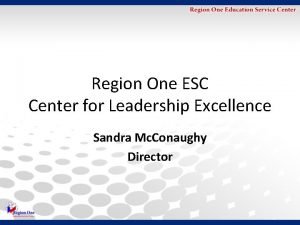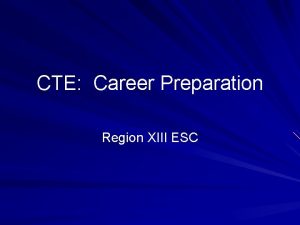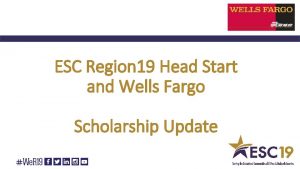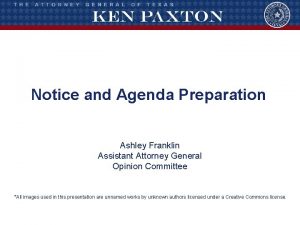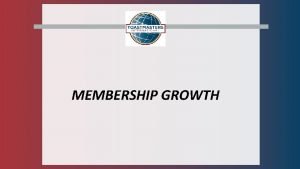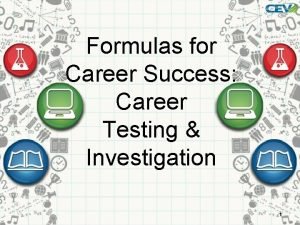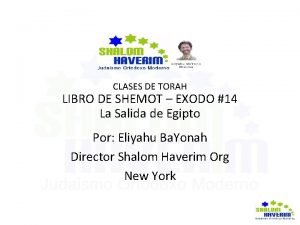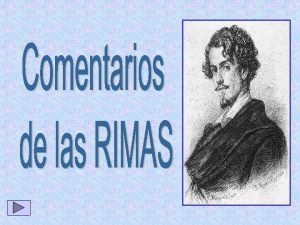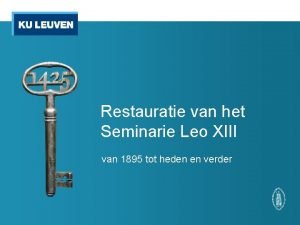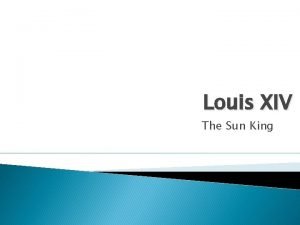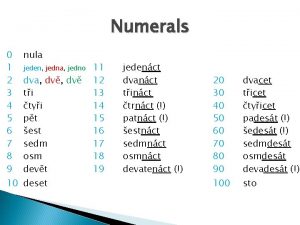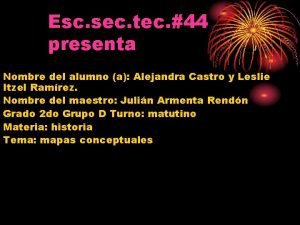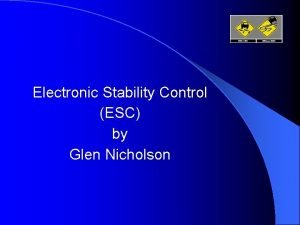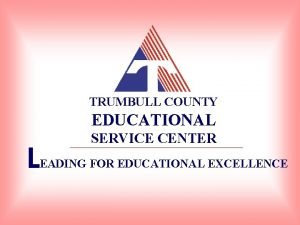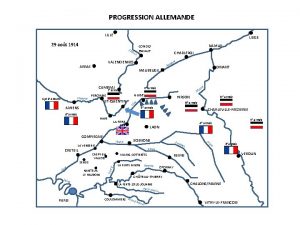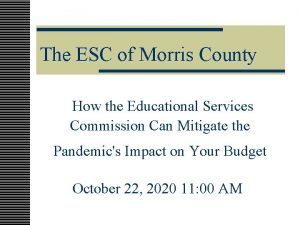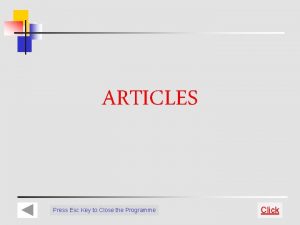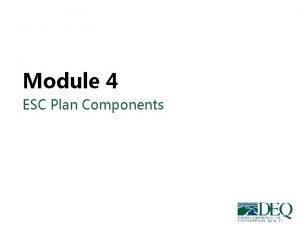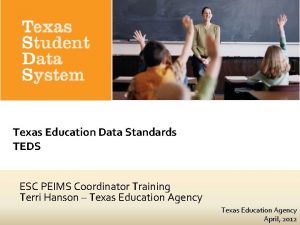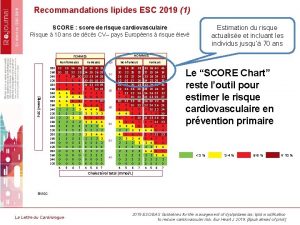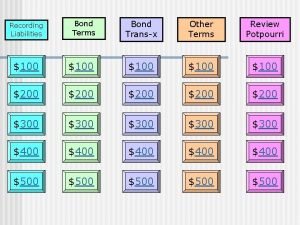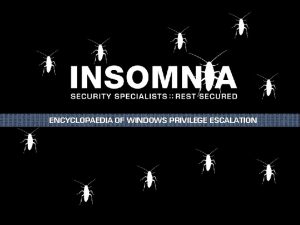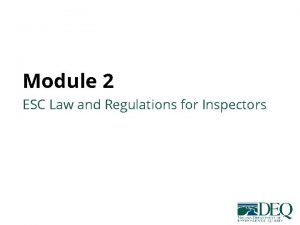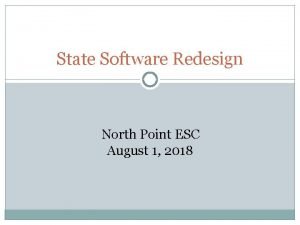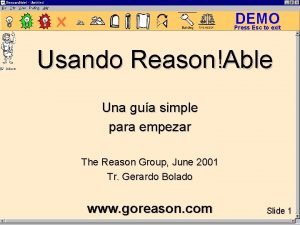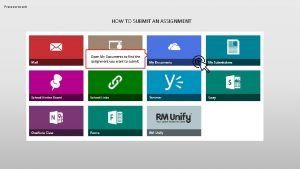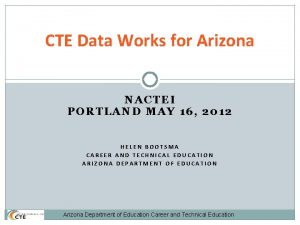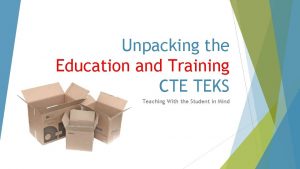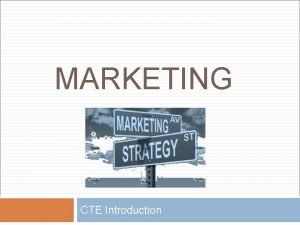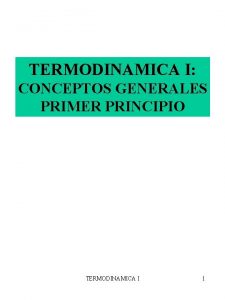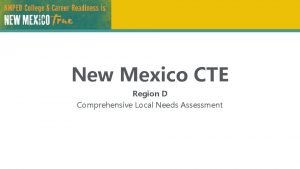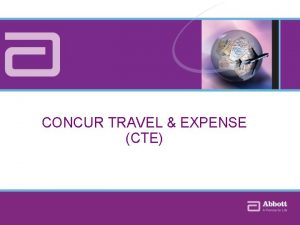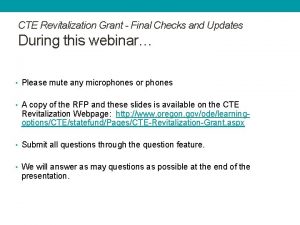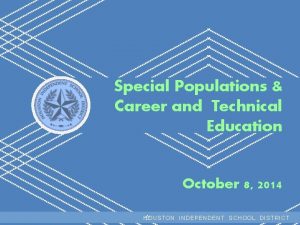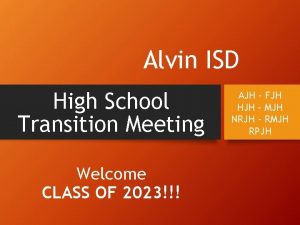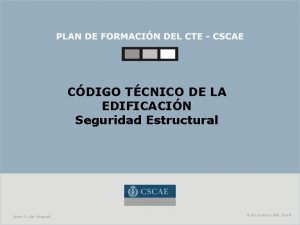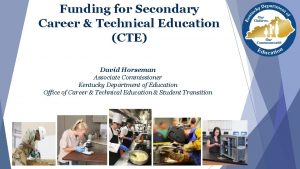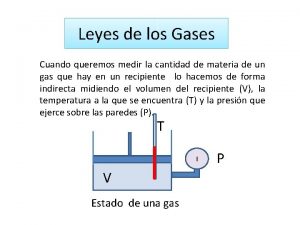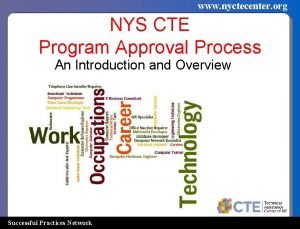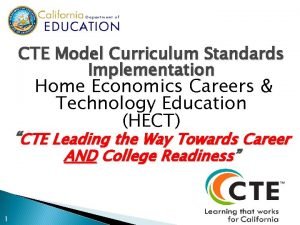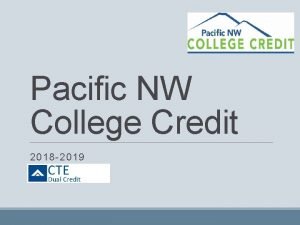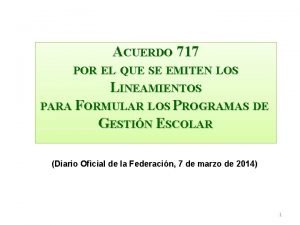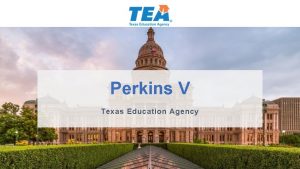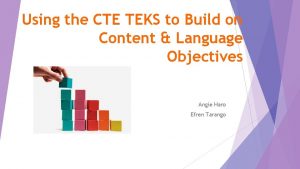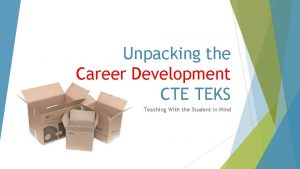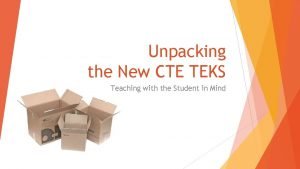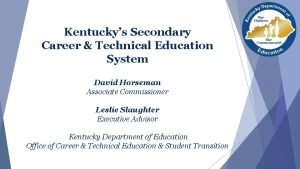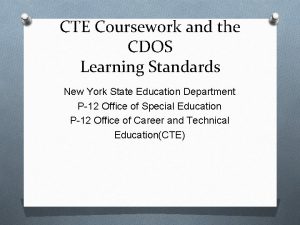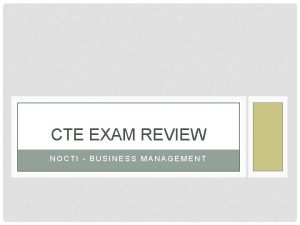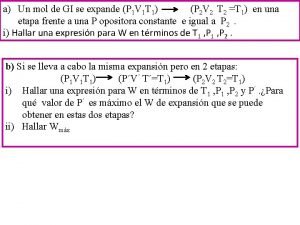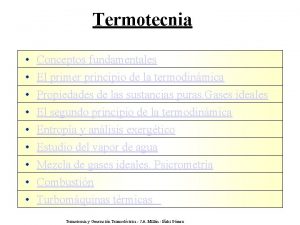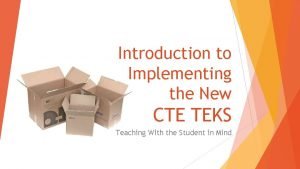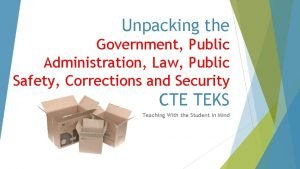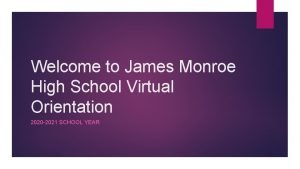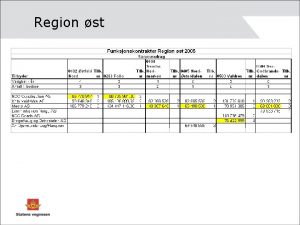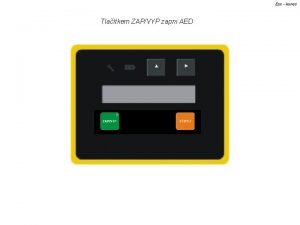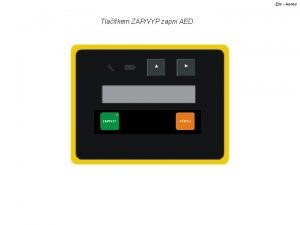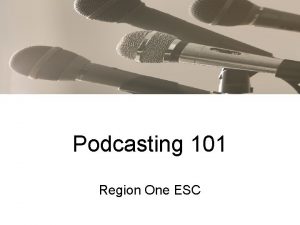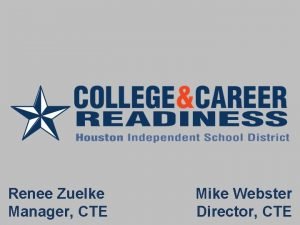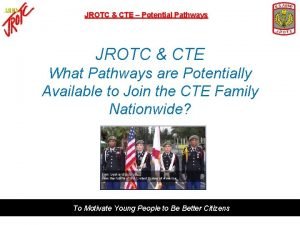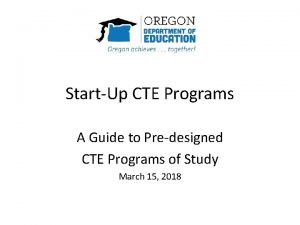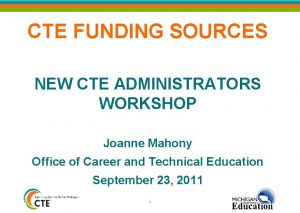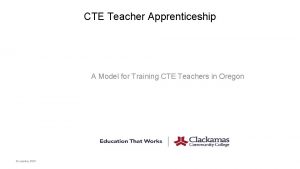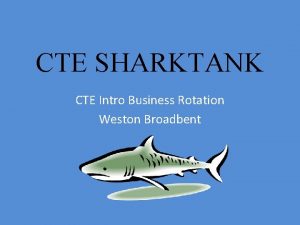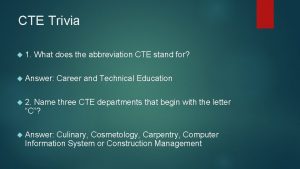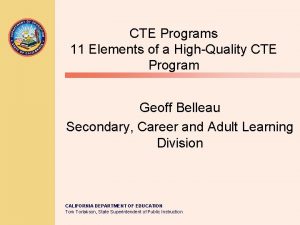CTE Career Preparation Region XIII ESC Agenda for

















































































































- Slides: 113

CTE: Career Preparation Region XIII ESC

Agenda for the Day Introductions Workforce Data Overview of Career Preparation Education Co-Op Calendar of Events Career and Technical Student Organizations (CTSOs) On-the-Job Safety Career Preparation/Innovative Courses Textbook and Curriculum Resources B. E. S. T. Partnerships Industry Advisory Groups Additional Sample Forms and Handouts 1

Introductions Your name Where you are from CTE certification area Years of teaching experience (CTE and/or other) Career Preparation course(s) you’re teaching 2

College: Worth the Price of Admission? 20/20 Segment http: //abcnews. go. com/video/player. Index ? id=6668451 3

SKILL DEMAND Research shows that a growing number of jobs require postsecondary education. But not all “good” jobs require a fouryear degree. www. Skills 2 Compete. org Source: http: //www. skills 2 compete. org/site/c. fh. LIKYPLLu. F/b. 3354601/k. ECF 2/Resources. htm 4

THE RESEARCH There is substantial demand to fill skilled jobs in the middle of the labor market, with many of these jobs paying quite high wages. At a minimum, demand for middlelevel skills and occupations will remain robust in the future, with jobs requiring post-secondary education or at least moderate-term training growing substantially over the next decade. . www. Skills 2 Compete. org 5 Source: http: //www. skills 2 compete. org/atf/cf/{8 E 9806 BF-4669 -4217 -AF 74 -26 F 62108 EA 68}/Forgotten. Jobs. Report%20 Final. pdf

www. Skills 2 Compete. org Resources: National and state research showing demand for middle-skill jobs Profiles of state efforts Resources that can help stakeholders get the word out about the need for a new 21 st-century approach to skills Media resources including profiles of the campaign’s endorsers Source: http: //www. skills 2 compete. org/site/c. fh. LIKYPLLu. F/b. 3354601/k. ECF 2/Resources. htm 6

The Texas Workforce Commission definitions: v High Wage occupations exceed the median weekly wage threshold for all earners ($13. 19/hr or $27, 433/yr) v High Demand occupations grow faster than average for all occupations in the 2004 -2014 projections (17. 6%) v High Skill occupations (not official definition) § 1) require licensure or § 2) require apprenticeship, or § 3) are identified by the Texas Skills Standards Board 7

Activity Individually complete the sections titled, “What I Know” and “What I Want to Learn” on your K-W-L Strategy Sheet. Be prepared to share. 8

SO… What exactly is Career Preparation Education? 9

Examples of Career Preparation Options… Job Shadowing Service Learning School-Linked Summer Employment Health Science Tech Clinical Rotations FACS Early Childhood Professions and Ready, Set, Teach! Workplace Mentorships Apprenticeships Internships Career Academies: School Based Enterprise Occupationally-specific Cooperative Education Programs Career Preparation 10

“Work Release” vs. Career Preparation Work-release students find their own jobs with no regard to training opportunities Students and teacher work together to find a training position in an occupational area Students can earn 2 to 3 high school credits No high school credits are earned No school supervision or follow-up for work-release students No related class instruction for work-release students. Regular visits are made to student’s employer to evaluate and follow-up student’s on-the-job training, performance and progress Students learn employability and workplace skills, as well as occupationally-specific content correlated with their career and academic goals Career Preparation students have the support of a trained educator in order to maximize their potential in preparation for a career in the global workforce. 11

Rationale for Career Preparation We remember 10% if we use only hearing We remember 15% if we use only vision We remember 40% if we use vision and hearing BUT We remember 80% by experiencing and doing! 12

Goals of Career Preparation Provide relevance and meaning to learning experiences Provide hands-on application Offer contextual & integrated learning experiences Demonstrate connections between school & work Encourage career awareness & exploration Learn relevant employability skills & what employers want Provide specific career preparation and skills of the job Give dignity to practical learning, application of knowledge, and work Provide a capstone experience for students involved in a career cluster pathway of study. 13

Disclaimer Today’s session will focus on “best practice” for coordination of Career Preparation experiences. Currently, TEA does not have an official guide to use for Career Preparation coordinators. However, there is talk that they may start the process of developing a guide for teachers to use in correlation to local district requirements for Career Preparation courses. Your local school district may impose any requirements necessary for participation in Career Preparation experiences by board approval. 14

Binder: Section 1 Overview

Career Preparation… Take a few minutes to look through Section 1 of the binder. The “Career Preparation Teacher Manual”. Jot down your questions…If not answered during the day, ask when needed. 16

Stakeholders Activity: – Discuss and generate a list of the responsibilities of the party assigned to your group in the career preparation process: (1) Teacher-Coordinator (2) Employer (3) Student (4) Parent (5) Counselor (6) Administrator 17

“Career Preparation Calendar of Events” What a Short Summer! July and August - when the teacher returns to campus (generally 3 to 4 weeks prior to teachers returning to campus) ü ü ü Get an updated list of students enrolled in Career Preparation and compare to applications Contact all students (have a job, need a job, seasonal job, want to change jobs, etc. ) Contact prospective employers Ensure that unemployed students know how to apply and interview for jobs Post available jobs for students to review 18

First Weeks of School August and September ü All students must agree to Career Preparation program guidelines ü All students must be employed within 15 days from the start of school (many districts require to be hired within 10 days or less, due to scheduling/credit issues) ü Career Preparation teacher verifies employment ü Career Preparation teacher prepares training plans ü Career Preparation teacher distributes signed and returned training plans 19

Middle to End of Grading Period October and Middle to End of Each Grading Period for the school year ü Prepare for and make employer visits ü Complete paperwork documenting employer visits • District travel form • Personal observation form ü Collect and score employer evaluations 20

School Year Continues January or February ü Market your CTE program ü Interested students complete application February or March ü Students pre-register for next year March until end of school ü Career Preparation teacher receives applications ü Career Preparation teacher meets with students ü Career Preparation teacher reviews pre-registration roster to secure applications from all students on list 21

Suggestion… Prior to the end of school (May) – Provide a social event inviting all current students and new applicants Pizza party during lunch Doughnuts before school Etc… (Food ALWAYS works ) 22

Why? Begins to build relationships and commitment from the new students Allows the new students a chance to ask questions of you and the other students Provides opportunity to collect parent permission slips allowing student to become involved in Career Preparation Program Gives you the opportunity to “Put a Name to Face. ” 23

Suggestion… Immediately following the end of school (June) – Conduct an Employability Skills “Boot Camp”… a 2 -3 day workshop for all applicants on: Interviewing techniques, Resume writing/Thank you letters, Applications, Dress, Etiquette, Etc. WHY? – Greatly minimizes your last minute scrambling by equipping the students with needed skills to job seek throughout the summer. 24

Binder: Section 2 Information from TEA-CTE

CTE State Plan 2008 -2013 Addresses these challenges: Ø Recognizing the unique needs of a Diverse Student Population ØPreparing students for College and Career Success ØPreparing students with a Quality Education that prepares them to be Competitive within a Global Economy ØRecruiting and Retaining Qualified Teachers Texas State Plan for CTE 2008 -2013 http: //www. tea. state. tx. us/cte/Accountability/State. Plan. Final 111607. pdf 26

Achieve Texas is making Career Preparation even more important as pathways are developed to include a capstone experience Each state-recognized program of study includes: v Rigorous secondary academic courses v Relevant, coherent sequence of CTE courses with college credit opportunities including dual credit, articulated credit, Advanced Placement and/or International Baccalaureate credit v Opportunities for industry-recognized certifications and licensures, where appropriate and available 27

Where do your classes fit? 28

2009 -2010 Student Attendance Accounting Handbook Take a quick look at these sections with me… 29

5. 2 Eligibility and Eligible Days Present q Each CTE course must be taught by a qualified/certified CTE teacher q The teacher of record must be the teacher in the classroom responsible for teaching and learning, grades, attendance, etc. q District must provide appropriate resources, laboratories, and technology to teach the TEKS for the courses offered. q To be eligible for CTE contact hour funding, district must offer three or more programs of study in at least three different clusters. (Most districts offer: IT/BCIS, Arts/AV, Ag, Ed/Training) 30

5. 2. 4 Career Preparation Eligibility Requirements q The career preparation training component whether paid or unpaid must address the TEKS for the course, provide a variety of learning experiences that will give broadest understanding of business/industry. q The course should span the entire school year, and classroom instruction must average one class period each day for every school week. q A student is expected to be enrolled the entire school year; however, in accordance with local district policy, a student may enter or exit the course when extenuating circumstances require such a change. q A minimum age of 16 is required to enroll in career preparation learning experiences. 31

5. 7. 1 Date on Which Students May Earn Contact Hours q Training plan on file within 15 instructional days of the student’s employment date 5. 7. 2 Additional Requirements q Employment must begin within 15 instructional days of student’s class enrollment date 5. 7. 3 Required Site Visits by Teachers q Teachers must visit each student training site at least six times each school year. 5. 11 Documentation q CTE teacher’s grade book documenting attendance, participation, and official grade reports are required. 32

TEA is “Here to Help” 2008 -2009 Student Attendance Accounting Handbook: “Where does it say that…? ” – http: //www. tea. state. tx. us/school. finance/handbook/in dex. html CTE Website: a valuable resource – http: //www. tea. state. tx. us/cte/index. html Career Clusters – http: //www. achievetexas. org/Implementation. htm 33

Binder: Section 3 Selection of Students and Employers

Student Enrollment Would you say your course or program is… Ø Growing? Ø Declining? Ø Staying the Same? Does your campus and/or district administration use student pre-registration data to determine which CTE courses to offer or drop? What are you doing to market your program? Discuss 35

Selecting Students (pg 3. 1) v Applications (pg 3. 2) distributed to interested students prior to preregistration v KEY: Building relationship with counselors! v Students return completed application to Career Preparation teacher or counselor v Career Preparation teacher reviews applications, checks attendance, and disciplinary file v Career Preparation teacher interviews each student v Purpose: Assess student interview skills and gain additional personal information v Final acceptance is based on student securing approvable job and parental permission 36

Helping Students Become Employed Students should prepare/update resume Teacher posts known job leads and/or former career preparation employers Teacher may provide business cards as “introduction” (“Boot Camp”) Teacher reviews businesslike dress and grooming expectations Students should know how to complete a job application neatly and accurately Students should rehearse before the interview Students should follow-up after the interview (with career preparation teacher and business/interviewer) Teacher offers encouragement and/or constructive suggestions as needed Teacher is not ultimately responsible for a student securing employment 37

Selecting Training Stations (pg 3. 4) The student’s supervisor is a teacher and a trainer § Should be capable, interested, and willing to give constructive help when needed Training stations should provide a variety of experiences in the student’s area of occupational interest § Should be progressive and rotate students into positions requiring high levels of skills § Most difficult to achieve The business organization should exemplify high ethical standards. § Should be a moral environment appropriate for young employees The training station should provide a safe environment for students. § Buildings, equipment, and grounds should meet local, state, and federal safety regulations. § Should not be in dangerous location or require late/odd business hours 38

Selecting Training Stations, continued The employer must be in compliance with all labor laws § Should comply with local, state, and federal regulations (minimum wage, working hours, overtime pay, hazardous occupations, etc. ) Student earnings should be comparable to similar jobs in the community ($7. 25 minimum wage as of 7/24/09) Existing versus Establishing Training Stations § What is the key difference? § Attention Business Owners (pg 3. 5) recruitment flyer 39

Binder: Section 4 Beginning-of-the-Year Activities

Student Data Form (pg 4. 1) Demographic info Employment info School schedule 41

Employment Search Log (pg 4. 2) Some students do not have jobs Students must secure approvable training positions as soon as possible This form provides documentation (or lack of it!) of student’s efforts to seek employment Students check in with career preparation teacher daily for job leads and/or log check 42

Expectations of Career Preparation Students If students enter career preparation program already employed, the job becomes the “training station” Students can’t quit or change jobs without talking with career preparation teacher in advance Career Preparation teacher encourages students to keep their jobs, rather than quitting if there are problems, to learn valuable communication and coping skills Their jobs are “your business” until the end of the school year Classroom form (pg 4. 3) § Go over on first day § Students sign and turn in to co-op teacher § Make a copy for students to keep in their folders as a reminder § Keep original copy in teacher files if needed to conference with student, parent, and/or campus administrator 43

Career Preparation Student/Parent Agreement (pg 4. 4) § Go over on first day § Section with general program guidelines and specific student expectations § Section for student and parent/guardian to read and sign § Keep in teacher file if needed to conference with student, parent, campus administrator, and/or employer 44

Activity… In your groups, review the sample Student/Parent Agreement Compare/Contrast how it relates to your own district’s student/parent agreement. How could your current agreement improve? If you do not have one for your district: – Highlight key items you would like to include. – Make notes of what you would else you would like to add. Be Prepared to Share… 45

Developing Training Plans (pg 4. 6) “A completed training plan for each student enrolled is mandatory for the district to claim contact hours for funding purposes. ” TEA offers forms in both paid and unpaid formats (see examples) Texas Workforce Commission and the US Department of Labor approved the design of the training plan Four copies should be prepared: 1. 2. 3. 4. Teacher’s file Employer Student Other as needed http: //ritter. tea. state. tx. us/cte/curriculum/index. html 46

Training Plans - Front Page (4. 8) Requires student data, so start a card file or database before school starts: Ø Student Name and Social Security Number Ø Occupational Objective and PEIMS Code Ø Name of Training Sponsor Ø Program area Ø Name of School District and Campus Ø Beginning Wage Ø Number of Hours of Training per Week Ø Beginning and Ending dates of Training Plan Agreement Ø Length of Probationary period (if applicable) Ø Appropriate signatures (Student, Parent, Employer, Coordinator) 47

PEIMS Codes For Career Prep – Use: Career Prep N 1295000 (for CP 1 and CP 2) Don’t use N 1295001 or N 1295002 these are teacher codes. – http: //www. tea. state. tx. us/peims/standards/0809/index. html 48

Training Plans – Back Page (pg 4. 11) TEKS and related instruction for Career Preparation course content Ø Ø Ø Must comply with Child Labor Laws and Fair Labor Standards Act Essential Knowledge and Skills should be utilized when appropriate Should emphasize safety consciousness and developing safe work habits and attitudes Ø Indicates supervision will be provided and duties will be rotated to allow progression of skills Ø Work experiences should be correlated to study assignments Ø Balance between general information and occupational competencies TEKS and related instruction for occupationally-specific content (see samples) Training Plan is not complete without Ø TEKS and assignments for course Ø TEKS and assignments for occupation 49

Distributing Training Plans Before giving training plans to students, make a copy Explain to students that front page requires four signatures v Student v Parent/Guardian v Teacher Coordinator v Employer/Supervisor (training sponsor) Original must be on file within 15 days upon securing employment (TEA can make your district return $$$) 50

After Training Plans are Signed Career Preparation teacher makes three copies v. Original goes to CTE Director (for funding and PEIMS documentation) v. Deliver employer’s copy at first evaluation visit v. Keep student’s copy in filing cabinet folder or in student’s folder v. Maintain file of teacher’s copies 51

Training Plan Packet – (Initial Employer Visit) Letter/Memo to employer q. Briefly reminding of expectations and evaluation procedures and thanking him/her Student/Parent Agreement Training Plan Sample Employer Evaluation TEKS and related instruction for Career Preparation course Child Labor Law information (pg 4. 13 -4. 14) ***Hint: Make a copy of front page before distributing to students! 52

Binder: Section 5 Ongoing Activities

Documenting Employment Weekly Job Report (pg 5. 1) Ø Used to document student hours 3 -credit course = 15+ hrs. in 7 -day period 2 -credit course = 10+ hours per week Ø Each week, student Completes hours worked each day per week Totals hours for the week Completes a few sentences on journal lines NOTE: Teacher checks each week! Ø At end of grading period, student Totals hours for grading period Submits form to Teacher (grade) Yearly Wage and Hour form (pg 5. 2) Ø Student logs weekly hours and grading period totals from wage and hour form Ø Student compares number of hours to ensure meeting recommended state requirement (15 hrs per week X 36 weeks in school year = 540 hrs for the year) Ø Keep form in teacher and personal student folder 54

Documenting Employment, continued First grading period ü Prepare a Training Station Info sheet (pg 5. 3) Students fill in blanks ü Prepare Employer Evaluation forms (pg 5. 4) ü Visit each training station Subsequent grading periods ü Students update Training Station info sheet ü Visit each training station 55

What Should an Evaluation Look Like? ACTIVITY: Review Employer Evaluation Sample (pg 5. 4) Within your group, generate a list of employee competencies that you would include in an evaluation Example: § Appearance and Grooming § Initiative § Etc. Then decide how you would rate the competencies 56

Visiting the Training Site Minimum of one visit (not phone call) is required each grading period; total of six visits per year. Must be documented! Before making employer visits – Tell students you are getting ready for visits: “Is there anything I need to know? ” – Prepare an employer evaluation form for each student (a new one at semester) – Put form in envelope for privacy and identification – Use Training Station Info sheet to plan travel (sort into groups according to areas of town) 57

Visiting the Training Site, continued Determine if your student is at work If student is there § Greet student and make positive comment about work he/she is doing § Ask for his/her immediate supervisor If student is not there § Ask for student’s immediate supervisor Be sensitive to whether this is a good time for a short conversation Briefly explain the evaluation form Limit visit to a reasonable length of time. If necessary, schedule a return visit to conference about the student. Tell/remind supervisor of procedure you have for getting evaluations back Leave your business card with supervisor 58

After Visiting the Training Site Documentation can be “when, where, who, and how far” on district travel form you submitted for payment when finished with visits § District may have special procedure for documentation § If student asks, “Who did you give my evaluation to? (so they know who to check with to get it back), you will know! Make a list and post it in classroom or by the door as you complete visits § Some students were at work and will know that you were there but others were not § They will know about when their evaluations should be ready When applicable, make comments in class about students at work 59

Quitting/Changing Jobs (pg 5. 5) Career Preparation students are expected to stay at present job for entire school year v They need to improve coping and communication skills (lifelong skills) v If they quit, they will have no grade for employer evaluation or Wage and Hour form v Program’s relationship with employers can be damaged (strong co-op programs are built on “repeat business” with satisfied employers) 60

Finding a New Job (pg 12. 15 -12, 17) Sometimes co-op students cannot stay at present job v Business reduces student hours below 15 per week v Business closes or moves out of the area v Situation warrants job change Must have new job within two weeks v Assist student with job leads v Student documents contacts made on employment search form (minimum of 3 per day) v Co-op teacher prepares new training plan 61

**Helpful Hints: Student Folder (on CD) Completed Application Student/Parent Agreement Training Plan including Child Labor Laws Evaluations Wage and Hour Reports 62

**Helpful Hints: Employer Visit Packet (on CD) Initial Visit: ü ü ü Initial Visit Memo 1 -2 Copies of the Standards of Operation 3 -4 Copies (NCR Paper if possible) of the student Training Plan including the Child Labor Laws 1 Sample Evaluation TEKS School Calendar Subsequent Visits: ü ü Evaluation Memo Evaluation (NCR Paper if Possible) 63

**Helpful Hints: Employer Recruitment Packet (on CD) Welcome Letter Attention Business Owners Flyer Sample Evaluation Sample Training Plan Business Card 64

Program Evaluation Samples Generic (pg 5. 7) Online (pg 5. 19) TEA Compliance Review as a starting point @ http: //ritter. tea. state. tx. us/pmi/ctemon/2009/reso urces/systemanalysis_CTE_09. doc 65

Shifting Gears 66

Binder: Section 6 Career and Technical Student Organizations (CTSOs)

Eight National Co-Curricular CTSO’s There is a CTSO for every discipline Included in federal legislation Endorsed by the National Association of Secondary School Principals Recognized by the U. S. Department of Education Supported by state directors of CTE and Supported by state departments of education, including TEA 68

Who are they? Business Professionals of America (BPA) Future Business Leaders of America (FBLA) 69

Who are they? An Association of Marketing Students Family, Career and Community Leaders of America (FCCLA) Family & Consumer Sciences Students 70

Who are they? National FFA Organization Health Occupations Students of America (HOSA) 71

Who are they? Skills. USA Industrial Education Students Technology Student Association (TSA) 72

TEA on CTSOs (pg 6. 3) Definition Financial Accountability Meal Expenses Credit Cards Planning and Management Professional Development Conferences 73

Sample: Operational Guidelines Handbook (pg 6. 20) Purpose and Benefits Overview of Each Organization General Policies for Advisors Expectations of Officers Fundraising Competitive Events Safe Travel Procedures 74

Also Included… Website Resources (pg 6. 2) Guidelines for Safer Travel Handbook (pg 6. 29) CTSO Internet Scavenger Hunt (National and State) (pg 6. 42) Student Organization Presentation Information Sheet (pg 6. 43) – Motivating your students to join! Sample Bylaws (pg 6. 44) 75

Connections CTSOs connect students to: – Industry – Instructors – Each other – Their own individual success – Team success 76

Activity How will you promote your Student Organization? Student Organization Presentation Information Sheet (pg 6. 43) – Take a few minutes to discuss and complete the Presentation Information worksheet – Be prepared to share 77

Binder: Section 7 On-the-Job-Safety

79

80

81

82

On-the-Job Safety Video: How To Survive and Thrive at Work: A Guide for Teenage Workers – http: //www. news 8 austin. com/content/top_stories/defaul t. asp? Ar. ID=228473 Department of Labor Resources - Hours Restrictions for Young Workers - Prohibited Occupations for Non-Agricultural Employees http: //www. dol. gov/elaws OSHA Resources – Teen Worker Safety http: //www. osha. gov/teens 83

Teen Worker Safety Posters Dos and Don’ts for Teen Workers *Child Labor Laws* (pg 5. 5) Youth Rules – Poster 1 (pg 5. 6) Youth Rules – Poster 2 (pg 5. 7) - Federal Youth Employment Laws 84

Related Websites US Department of Labor – http: //www. dol. gov OSHA’s Teen Workers – http: //www. osha. gov/teens Youth Rules! – http: //www. youthrules. dol. gov Youth at Work - http: //www. youth. eeoc. gov Texas Workforce Commission - http: ///www. texasworkforce. org Farm Safety 4 Just Kids - http: //www. fs 4 jk. org 85

Safety Websites & Resources Youth in Agriculture e-Tool - http: //www. osha. gov/SLTC/youth/agriculture Teen Worker Safety in Restaurants e-Tool - http: //www. osha. gov/SLTC/youth/restaurant Teen Worker Safety in Health Services - http: //www. osha. gov/SLTC/etools/hospital National Institute for Occupational Safety & Health – http: //www. cdc. gov/niosh/fed. Net/ – http: //www/cdc. gov/niosh/talkingsafety/states/tx 86

Student Certifications OSHA Safety Certification - http: ///www. careersafeonline. com/ Food Handlers Certification - http: //www. State. Food. Safety. com Texas Restaurant Association - http: //www. restaurantville. com National Retail Federation Foundation - http: //www. nrffoundation. com 87

Binder: Section 8 Innovative Courses

Career Preparation (Formerly Diversified Career Preparation) Career Preparation is no longer an innovative course, as of 2008 -2009, any district can offer it pending School Board Approval Appropriate TEKS almost-perfectly aligned to Glencoe textbook: Succeeding in the World of Work 89

References/Forms Innovative Course Procedures Sample Innovative Course Application (2009) Sample CP Approved Application (on CD) 90

Binder: Section 9 Textbook and Curriculum Resources

Textbook & Curriculum Resources The 16 Career Clusters Adoption Cycle (revised May 2008) EMAT Adoption Bulletin Factors to Consider Before Selecting Electronic Textbooks Factors to Consider Before Selecting Technological Equipment List of Adopted Materials for Career & Technical Education Courses 92

CTE Curriculum Resources Materials available free or for purchase through state-funded curriculum centers Materials available for purchase from national curriculum centers Materials available free or for purchase from industry-related sources 93

Curriculum Centers Texas A&M University – Corpus Christi - Ag Science and Trade & Industry Education, Agriculture, Food & Natural Resources http: //www-ims. tamu. edu Texas Tech University - Education & Training, Hospitality & Tourism, Human Services http: //www. hs. ttu. edu/ccfcs/ University of North Texas - Architecture & Construction, Arts, A/V Technology & Communications, Business Management & Administration, Finance, Government & Public Administration, Health Science, Information Technology, Law, Public Safety, Corrections & Security, Manufacturing, Marketing, Science, Technology, Engineering & Mathematics http: //www. texashste. com/ 94

Binder: Section 10 B. E. S. T Partnerships

Texas B. E. S. T (Business Education Support Teams) Primary goal of Achieve. Texas is to… Vastly increase the quantity and quality of partnerships 96

Texas B. E. S. T Partnership is one of the basic principles of Achieve. Texas, particularly between education and business. Purpose: Bring together leaders from education, business and industry, government agencies, professional and trade organizations in an effort to “build buy-in to the redesign of Texas Education, so that all share a common vision. ” The idea is to spread the tasks of system building over large groups of educators and employers. It’s the entire community’s job to help construct a strong pathways system for schools and students. 97

A key message so far… Partnerships are an avenue for the business and education communities to positively interact Partnerships are a two-way street for education and business to provide expanded opportunities for students Any size business can improve the quality of your CTE program Any size CTE program can utilize resources from its local business community 98

ACTIVITY Read examples of School & Business Partnerships (pg 10. 2 -10. 3) • Read examples: 5 minutes • Discuss examples with your group: 5 minutes • Present ideas • Can any of these ideas apply to your CTE program? 99

ACTIVITY Using poster paper…with your group identify ways to develop partnerships in your CTE program Post your lists on the walls for review Partnership Possibilities Reflection (pg 10. 6) 100

Binder: Section 11 Industry Advisory Committees

Advisory Committees “Partners in Education” for CTE

Advisory Committee Defined A group of individuals who: Ø Form a partnership to improve student learning Ø Through identified goals that create a means for curriculum to remain relevant Ø Assure that graduates will be capable of performing entry-level jobs Bottom Line: Do graduates possess entrylevel job skills needed by community employers? 103

Advisory Committee Purpose Develop long- and short-term goals specific to program needs Conduct annual program evaluations Provide curriculum development and content advisement, including new technology developments in the workplace Provide awareness of program through promotional techniques Provide review of CTE program equipment, facilities, and resources Provide an opportunity to increase professionalism within the educational environment 104

Development of Advisory Committees Once voluntary, becoming mandatory via Performance Based Monitoring indicators and Career Cluster Implementation Consult your administration…their support is CRITICAL 105

Advisory Committee Specifics Size • 5 -10 works best • Identify stakeholders of your program Terms of Service • Best—two-year terms, rotation of new members each year. Three-year terms also work well. Procedures • Terms of service, responsibilities, sub-committees, establishing Program of Work, guidelines for meetings (length, number), minutes Agenda and Minutes • Agenda sent in advance; minutes sent after meeting 106

ACTIVITY Using the Advisory Committee Planning Guide (pg 11. 3) as a reference, create a list of people who should attend your first Advisory Committee meeting AND list the 3 objectives for the first meeting. If you do not know exact names, list titles of individuals, such as: • Dentist • Middle School Principal • HEB Manager 107

Binder: Section 12 Sample Forms and Handouts

Sample Packets Student Folder (on CD) Employer Visit Folder (on CD) Employer Recruitment (on CD) 109

Additional Forms and Resources CD and DVD Provided! 110

Endorsement Upon completion of the workshop, participants receive a certificate that satisfies the State Board for Educator Certification Assignment Rule for Work. Based learning professional responsibilities. Place a copy of your certificate in your personnel file with your Human Resources Office. 111

Wrap up Contact Information: – Traci Donovan, CTE Education Specialist Region XIII Education Service Center 5701 Springdale Rd. Austin, TX 78723 – E-mail: Traci. Donovan@esc 13. txed. net – Phone: (512) 919 -5434 – FAX: (512) 919 -5320 112
 Region 1 esc
Region 1 esc Region one esc
Region one esc Esc region 1
Esc region 1 Esc19hs
Esc19hs Agenda sistemica y agenda institucional
Agenda sistemica y agenda institucional Agenda preparation
Agenda preparation Agenda preparation
Agenda preparation Interview success formula self assessment
Interview success formula self assessment National career clusters framework
National career clusters framework Formulas for career success
Formulas for career success Louis xiii accomplishments
Louis xiii accomplishments Shemot (éxodo) xiii (11 - 14)
Shemot (éxodo) xiii (11 - 14) Capitulo xiii evangelho segundo espiritismo
Capitulo xiii evangelho segundo espiritismo Soneto xiii garcilaso metrica
Soneto xiii garcilaso metrica Leone xiii
Leone xiii Rima xiii
Rima xiii Leo xiii leuven
Leo xiii leuven Louis xiv accomplishments
Louis xiv accomplishments Figuras literarias del soneto xiii de garcilaso de la vega
Figuras literarias del soneto xiii de garcilaso de la vega Verb 1 2 3 4 5
Verb 1 2 3 4 5 Ausias march poema xiii
Ausias march poema xiii Pavillon de chasse louis xiii
Pavillon de chasse louis xiii Louis xiii absolutism
Louis xiii absolutism Canto xiii parafrasi
Canto xiii parafrasi Jaki jest najkrótszy tren jana kochanowskiego
Jaki jest najkrótszy tren jana kochanowskiego /forum/ xiii
/forum/ xiii Sec tec 44
Sec tec 44 What is esc
What is esc Projet esc
Projet esc Esc router
Esc router Trumbull county esc
Trumbull county esc Esc lorain county
Esc lorain county Progression pédagogique esc
Progression pédagogique esc Esc of morris county
Esc of morris county Esc
Esc Esc 18
Esc 18 Texas education data standards
Texas education data standards Ecole de commerce neuveville
Ecole de commerce neuveville Score esc 2019
Score esc 2019 Transx esc
Transx esc Windows xp sp1 privesc
Windows xp sp1 privesc Esc 101
Esc 101 Esc law regulations
Esc law regulations North point esc
North point esc Press esc to exit
Press esc to exit Esc la neuveville vacances
Esc la neuveville vacances Press esc to exit
Press esc to exit Quadrangular space content
Quadrangular space content Active region and saturation region
Active region and saturation region Cte technical skills assessments.azed.gov/student
Cte technical skills assessments.azed.gov/student Unpacking the teks
Unpacking the teks Printable nba logo
Printable nba logo V=cte
V=cte Cte school new mexico
Cte school new mexico One concur.abbott.com
One concur.abbott.com Cte revitalization grant
Cte revitalization grant Hisd cte
Hisd cte Jbh alvin isd
Jbh alvin isd F
F Cte seguridad estructural
Cte seguridad estructural Jctc jessamine county
Jctc jessamine county Ecuación general de los gases
Ecuación general de los gases Nysed cte program approval
Nysed cte program approval Cargas muertas cte
Cargas muertas cte Cte anchor standards
Cte anchor standards Pacific nw college credit
Pacific nw college credit Normalidad mínima de operación escolar
Normalidad mínima de operación escolar Cte funding texas
Cte funding texas Teks cte
Teks cte Afnr teks
Afnr teks Unpacking the teks
Unpacking the teks David horseman
David horseman Plataforma cte durango
Plataforma cte durango Cdos learning standards
Cdos learning standards Nocti general management study guide
Nocti general management study guide Transformacion politropica
Transformacion politropica Cte he 5
Cte he 5 V=cte
V=cte Transformation isochore
Transformation isochore Texas cte teks
Texas cte teks Texas cte resource center
Texas cte resource center Pv=cte
Pv=cte Cte programs of study
Cte programs of study Tack för att ni lyssnade bild
Tack för att ni lyssnade bild Strategi för svensk viltförvaltning
Strategi för svensk viltförvaltning Ro i rom pax
Ro i rom pax Ledningssystem för verksamhetsinformation
Ledningssystem för verksamhetsinformation Typiska drag för en novell
Typiska drag för en novell Tack för att ni har lyssnat
Tack för att ni har lyssnat Centrum för kunskap och säkerhet
Centrum för kunskap och säkerhet Läkarutlåtande för livränta
Läkarutlåtande för livränta Inköpsprocessen steg för steg
Inköpsprocessen steg för steg Påbyggnader för flakfordon
Påbyggnader för flakfordon En lathund för arbete med kontinuitetshantering
En lathund för arbete med kontinuitetshantering A gastrica
A gastrica Egg för emanuel
Egg för emanuel Atmosfr
Atmosfr Standardavvikelse
Standardavvikelse Rutin för avvikelsehantering
Rutin för avvikelsehantering Presentera för publik crossboss
Presentera för publik crossboss Klassificeringsstruktur för kommunala verksamheter
Klassificeringsstruktur för kommunala verksamheter Myndigheten för delaktighet
Myndigheten för delaktighet Att skriva en debattartikel
Att skriva en debattartikel Kung som dog 1611
Kung som dog 1611 Tack för att ni lyssnade
Tack för att ni lyssnade Tobinskatten för och nackdelar
Tobinskatten för och nackdelar Tack för att ni lyssnade bild
Tack för att ni lyssnade bild Mall för referat
Mall för referat Byggprocessen steg för steg
Byggprocessen steg för steg Brunn karttecken
Brunn karttecken Mitos steg
Mitos steg Fuktmätningar i betong enlig rbk
Fuktmätningar i betong enlig rbk Tryck formel
Tryck formel Elektronik för barn
Elektronik för barn
